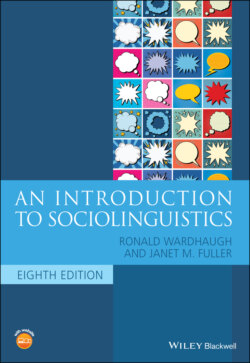Читать книгу An Introduction to Sociolinguistics - Ronald Wardhaugh, Janet M. Fuller - Страница 19
Variation
ОглавлениеThe competence–performance distinction just mentioned is one that holds intriguing possibilities for work in linguistics, but it is one that has also proved to be quite troublesome, because the performance of different language users, and the same person in different contexts, can vary quite a lot. For instance speakers in some areas of the Midwestern United States might utter sentences such as ‘The car needs washed’ while others would say ‘The car needs to be washed’ or ‘The car needs washing.’ Further, an individual speaker might use all three of these constructions at different times. (These different structures for expressing the same meaning are called variants; we will explain this term and how it is used in more detail below.) For sociolinguists, this linguistic variation is a central topic, and a core belief is that variation in language is socially meaningful. There is variation across language users, that is, reflections of different ways that people use a language in different regions or social groups, but also variation within the language use of a single person. No one uses language the same way all the time, and people constantly exploit variation within the languages they know for a wide variety of purposes. The consequence is a kind of paradox: while many linguists would like to view any language as a homogeneous entity, so that they can make the strongest possible theoretical generalizations, in actual fact that language will exhibit considerable internal variation. One claim we will be making throughout this book is that variation is an inherent characteristic of all languages at all times, and the patterns exhibited in this variation carry social meanings. (See the link to a website which provides an overview of the field, the sociolinguistics page for the PBS series Do You Speak American, in the materials associated with chapter 1 in the web guide to this textbook.) Thus, sociolinguistics is concerned with language not as an abstraction, but in the forms in which it is used.
Variation can occur on all linguistic levels, including lexical, phonetic, or morphosyntactic features. Lexical variation is exemplified by different words for the same thing – for instance, while Canadians go to the washroom, their US neighbors often say they are headed for the bathroom or the restroom, while elsewhere in the English‐speaking world, people use the toilet or the loo. Phonetic variation has to do with different pronunciations, for example, the pronunciation of words such as playing with a final ‐in’ (alveolar nasal) or ‐ing (velar nasal). The car needs washed/washing example above shows morphosyntactic variation; a further example of morphological variation is the use or non‐use of verbal ‐s marking on third person singular verbs, e.g., he plays versus he play. These examples illustrate variation associated with different social meanings (a topic which will be taken up in the next chapter) – washroom/bathroom/toilet/loo and needs washed/washing are examples of regional variation, ‐in’/‐ing variation has to do with the level of formality, and the use or non‐use of verbal ‐s is part of standardized and non‐standardized varieties of English. But of course, a single speaker might also use all of these variants, especially the phonetic and morphological variants. Certainly every English speaker has said both playin’ and playing in different contexts!
Further, while there is considerable variation in the speech of any one individual, there are also definite bounds to that variation: no individual is free to do just exactly as they please so far as language is concerned. You cannot pronounce words with random sounds, inflect or not inflect words such as nouns and verbs arbitrarily, or make drastic alterations in word order in sentences as the mood suits you. If you do any or all of these things, the results will be unacceptable, even gibberish. The variation you are permitted has limits (at least if you want to be understood!), and these limits can be described with considerable accuracy. For instance, although most of us would say ‘the cow jumped over the fence,’ we can say, ‘It is the fence that the cow jumped over,’ which is comprehensible if somewhat stilted; but most people would agree that ‘the fence jumped the cow over’ does not follow English word order rules and is largely incomprehensible. Most language users know what utterances are part of the language – or at least their variety of the language – although they do not usually know the linguistic rules; such explanations are the job of linguists!
Our task will be one of trying to specify the norms of linguistic behavior that exist in particular groups and then trying to account for individual behavior in terms of these norms. This task is particularly interesting because most people have no conscious awareness of how their linguistic behavior is conditioned by social norms. We will also see how the variation we find in language allows changes to occur over time and often points to the direction of change. A living language not only varies, it changes.
